I always considered myself a bit of an experimental prepper, testing out different methods, theories, and DIY preservation techniques. That’s why, ten years ago, I rendered down some beef tallow, sealed it up in a jar, and stashed it away. I was curious: how long could this stuff actually last? Would it go rancid in a few years, or would it still be as good as the day I sealed it?
Fast forward a decade, and I was ready to find out. I went down into my storage area, found the jar (still sealed tight and looking pretty much exactly like it did ten years ago), and decided to open it up. Here’s what I learned from cracking open a jar of beef tallow that’s been sitting for a decade.
The Visual Check
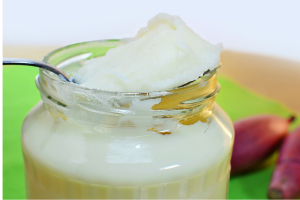 The first thing I did was give the jar a thorough visual inspection. I’m no stranger to mold or things going bad, so I knew what I was looking for. I’d sealed the tallow in a clean, sterilized glass jar, and the lid had remained intact the entire time—no leaks, no rust, no broken seal. It may have helped that I kept it in the root cellar I built myself.
The first thing I did was give the jar a thorough visual inspection. I’m no stranger to mold or things going bad, so I knew what I was looking for. I’d sealed the tallow in a clean, sterilized glass jar, and the lid had remained intact the entire time—no leaks, no rust, no broken seal. It may have helped that I kept it in the root cellar I built myself.
From the outside, the tallow looked fine. It still had that creamy white color that I remembered. There was no noticeable discoloration, no separation of strange liquids, and no sign of mold. So far, so good.
When I unscrewed the lid, there was that satisfying pop of a well-maintained seal. I took a moment to smell it, because, honestly, if anything was going to give away its age, it would be the scent.
The Smell Test
Beef tallow has a distinct smell; rich, a little meaty, but not overwhelmingly so. I took a whiff, and to my surprise, it still smelled… fine. It wasn’t rancid. There were no sour or off-putting notes, nothing that made me recoil. It smelled like beef tallow, just like the day I sealed it. If you’ve ever opened a jar of old oil that’s gone bad, you know it’s a smell that hits you immediately. This had none of that.
I should note that I stored this jar in a cool, dark area the entire time; a basement storage closet that stays pretty consistent in temperature. Temperature fluctuations can cause fats to go rancid more quickly, and I’m sure that the steady environment played a big role in how well it held up.
Texture and Consistency
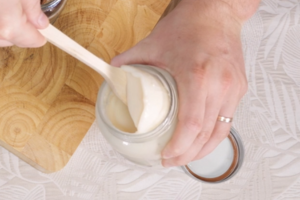 Next, I used a clean spoon to scoop out a bit of the tallow. Texture-wise, it was just as solid as I remembered. It’s important to note that beef tallow is quite stable at room
Next, I used a clean spoon to scoop out a bit of the tallow. Texture-wise, it was just as solid as I remembered. It’s important to note that beef tallow is quite stable at room
temperature, and the consistency hasn’t changed at all. It was still smooth, a bit waxy, and had no signs of graininess or separation.
There was no liquid pooling at the top of any hard crusty layer that sometimes develops on old fats. If I hadn’t known this jar was ten years old, I could have easily been fooled into
thinking it was fresh. I was honestly impressed.
The Taste Test
This was the real test; actually tasting the tallow. Now, I’m not one to recommend that anyone just dive in and eat decade-old preserved food without a little caution.
But, after the visual check, the smell test, and the consistency check, I was confident enough to give it a try.
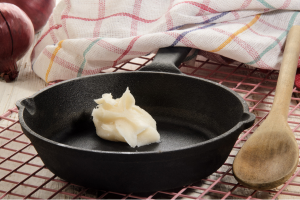
I decided to do a small test by frying up some potatoes in it. I figured that if there were any off flavors, it would come through in the taste. I melted a bit of the tallow in a cast-iron skillet, and again, there was no weird smell as it heated. It melted down smoothly, with the same color and texture as fresh tallow.
Related: 10 Foods You Should Store in Lard for a Long Shelf Life
Once the potatoes were done, I took a tentative bite. To my surprise, they tasted… normal. There was no funky aftertaste, no bitterness, nothing to suggest that the tallow had gone bad. It imparted that same rich, savory flavor that I’d expect from beef tallow. In short, it was still completely usable.
Why Beef Tallow Lasts So Long
Beef tallow is one of those old-school fats that has a lot of staying power. It’s high in saturated fat, which makes it far more stable than vegetable oils or even lard. The rendering process removes impurities, and when properly stored in a sterilized jar with a good seal, tallow can last a very long time.
It’s worth noting that tallow was a staple for our ancestors long before refrigeration. This is how they made it to last a really long time. They would use it for cooking, candle-making, and even as a skin balm. Its long shelf life made it invaluable for homesteaders and pioneers who needed reliable sources of fat that wouldn’t spoil easily.
Factors That Affect Tallow’s Shelf Life
Reflecting on this experiment, I realized just how much the storage conditions mattered. Here are a few key factors that I believe contributed to the tallow’s longevity:
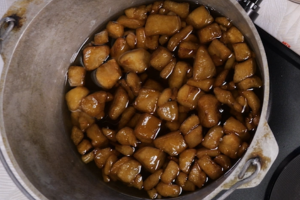 Proper Rendering: When I originally rendered the tallow, I took care to do it slowly and thoroughly, making sure to strain out any bits of meat or impurities. Those little bits can spoil over time and cause the whole batch to go bad.
Proper Rendering: When I originally rendered the tallow, I took care to do it slowly and thoroughly, making sure to strain out any bits of meat or impurities. Those little bits can spoil over time and cause the whole batch to go bad.- Sterilized Jar and Good Seal: I used a sterilized glass jar and made sure the seal was tight. Any bacteria that gets into the jar can cause spoilage, so keeping everything clean is crucial.
- Cool, Dark Storage: The jar was stored in a cool, dark place, away from temperature fluctuations and light. Heat and light are enemies of fat storage, as they can speed up the process of rancidity.
What I Learned
So, what did I learn from opening a ten-year-old jar of beef tallow? First, I learned that when properly rendered and stored, beef tallow is incredibly resilient. It’s a testament to the value of traditional preservation methods and the benefits of having a reliable fat source in long-term storage.
I also learned the importance of proper technique. If I’d been careless when rendering the tallow or sealing the jar, I’m sure the outcome would have been very different. This experiment reinforced the idea that attention to detail can make or break your food storage efforts.
Finally, I learned that having a variety of preserved foods, including fats like tallow, is a smart move for any prepper. Fats are often overlooked in long-term food storage, but they’re crucial for a balanced diet and provide much-needed calories, especially in a survival situation. The fact that this tallow held up so well over ten years means it’s something I’ll definitely keep in my storage rotation.
Should You Store Beef Tallow Long-Term?
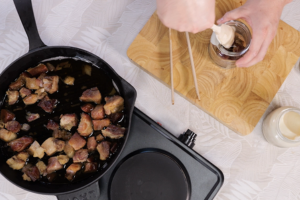 If you’re considering adding beef tallow to your long-term storage, I’d say go for it; with some caveats. Make sure you render it properly, store it in sterilized jars, and keep it in a stable environment. If you do that, you might be surprised at just how long it can last.
If you’re considering adding beef tallow to your long-term storage, I’d say go for it; with some caveats. Make sure you render it properly, store it in sterilized jars, and keep it in a stable environment. If you do that, you might be surprised at just how long it can last.
Tallow is versatile. You can use it for frying, baking, or even making emergency candles if you’re in a pinch. Plus, unlike many modern cooking oils, it’s free of additives and stabilizers that can affect its shelf life.
Final Thoughts
Opening that decade-old jar of beef tallow was a fascinating experience. It showed me just how effective traditional preservation methods can be when done right. Not only was the tallow still good, but it was also just as flavourful and useful as the day I rendered it using this recipe.
For those of us who like to be prepared, having a reliable source of fat in our storage is invaluable. This experiment has given me even more confidence in beef tallow as a long-term storage option, and I hope it inspires you to give it a try as well.
Whether you’re an experienced prepper or just starting out, beef tallow is definitely worth considering. Just be sure to render it well, store it properly, and enjoy the peace of mind that comes with knowing you’ve got a reliable fat source that can stand the test of time—even a decade or more.
You may also like:
10 Things You Should Never Do When The Power Goes Out
What Amish Would Never Store in Their Pantry, but Most Americans Do! (Video)
How To Get Back Home After An EMP Strike

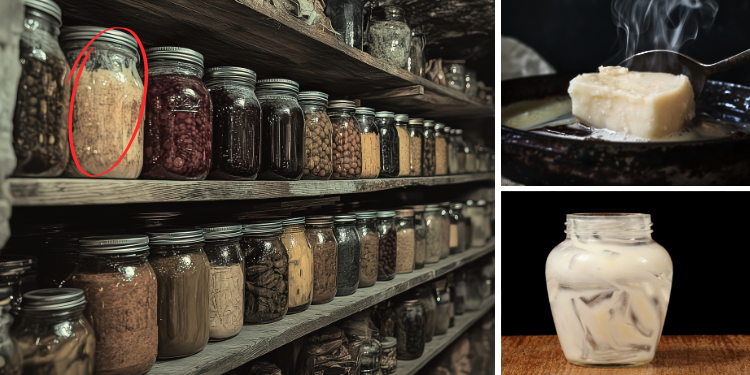





















Was tallow hot when you put it in the jar ?
Don’t overheat it, as this will turn it yellow, but it is still usable if you do. Heat it enough to kill bacteria. But it needs only be warm (liquid) for transfer into a storage jar. By the way, anyone who thinks of using tallow or bear grease to lubricate gun barrels or bullets (often mixed with soft wax for the latter), don’t forget to heat the grease over a large amount of water, heat it, and stir it well into the water when it is liquid as you purify it. This de-salts the grease, so that your gun barrel won’t be ruined. Animal greases have a lot of salt in them, until you dissolve that away in hot water.
Bill even if you haven’t overheated tallow or lard, the liquid often looks yellow when you pour it in the jar. As it cools, the color changes from yellow to white.
For those new to rendering, the better you strain out the impurities, the better end product. The cracklings (the rendered bits that were the chunks of fat you started with and now little pieces) are edible. Some like them as snacks, others use them like bacon bits. Animals like them, too.
If you’re trying to get every last drop of the fat from the suet or lard, you might accidentally squeeze some cracklings into your jar.
If that happens, the sediment will settle at the bottom. If desired, once contents are cooled, you can scoop out all the white tallow or lard and leave behind the last little bit. The dirty stuff you can use up right away if you don’t want to waste it.
Great to hear , but ten years
proper sterilization , seal, heating to proper temps , and then allow to cool gradually
No changes in Storage Temps
as the earth cellars are a constant
natural , not dependent on outside conditions
Wood , Soil , Dirt are best
Moisture barriers and seals so as not to create Mold , and critter invasion
but most of all for the area you live and and conditions you have around you
I gave up on long term storage , longer than 5 years , to short term 1-5 year
Well done! Just goes to show that if you store most anything properly it has the potential to still be edible even after a decade or so. Wish peanut butter lasted longer. The oil becomes rancid after a relatively short time. But there’s even a way around that to save most of a jar of peanut butter. Only the oil becomes rancid. Not the peanut butter itself. And the oil tends to gather at the top.
Armin
Hello my friend.
I agree with you, love my peanut butter.
stay sharp
red ant
When you canned it did you water bath or pressure can it? Or just put in the sterilized jar with a lid to seal it? That is important information to relay to us.
Thanks
Hi. Is your tallow recipe only good for beef or can it be the fat off any farm animals? Or even wild game?
I raise sheep for example and hunt deer. So just wondering.
Beef tallow is good. Sheep tallow (de-salted) is beloved, for instance, for lubricating bullets in a number of popular formulas. To my knowledge, though, only beef and sheep yield tallow. Pigs and chickens, etc., yield quite different, other oils and greases.
You’re obviously correct, Bill. Different rendered fats from different animals have different properties. As i know you’re aware pig fat is called lard. Couldn’t find the proper name for chicken fat. As far as I know it’s just chicken fat. Makes for a very nice chicken soup though. Especially when you’re feeling a little under the weather. Chicken soup and homemade dumplings. M’mmm, m’mmm, good! 😉 Of the many different fats we get from animals chicken fat is the only one high in linoleic acid. An omega 6 fatty acid. In concentrations between about 18 and 23%. Consuming linoleic acid helps to lower the risk of cardiovascular disease, diabetes and premature death. There seems to be some pretty good evidence that getting more linoleic acid in your diet helps to decrease total blood cholesterol and low-density lipoproteins. What I do know for sure is that if I have some homemade chicken soup I DO feel much better.
Ain, chicken fat is known as schmaltz.
Hmm first it said it was stored in a root cellar and then a room in the basement. Maybe that was the root cellar but why not call it the same thing both times.
I noticed that, too, Tara.
I opened a quart jar of beef tallow from 2019 about 2 weeks ago to see. It’s been stored in a closet. Where I live you can’t have basements, root cellars or anything more than 3 feet below surface. The closet stays dark for weeks at a time and only opened and closed with a room light. I also opened corn, carrots and Jimmy Dean sausage from 2021. Same place and it was all fine. It pretty much stays 72 degrees or cooler in the winter month. I sterilize the jars in boiling water and pour hot tallow from the crock pot right in and seal until cool and the lid is sealed. One I put in the fridge and the others are stored. I don’t water bath those. Everything else is either pressured canned or water bath.
Great article on learning it’s the storage as much as the process. I have a bunch of clear glass jars but I am thinking on getting blue to stop direct light on contents. It may help if it all needs to be moved or used.
The only thing more important than being prepared for physical needs is, having your soul prepared. This life expires. The next one is eternal.
I agree with you, Chaplain Dan. While maintaining this body is important for our earthly survival; at this time in our history it’s even more important than ever for our spiritual development. I truly believe that all the chaos happening all around us is more a spiritual war against us than anything else. The eternal war of light against dark with us being the “prize”. This body is just a “costume” we wear and it changes from lifetime to lifetime. I don’t think the next life is eternal rather, we, as powerful spiritual beings are eternal. Having been created by that which we call god so that god, through us, can experience this 3rd dimensional realm and evolve as a result. All dimensions or planes of existence are only separated by frequency and when this body dies and we leave it as pure spirit we move to the next higher dimension because as pure spirit our frequency is too high to any longer exist in this 3 dimensional realm of duality. We come here to experience and learn and we do it over and over again until we’ve learned all the lessons that we were supposed to.
we have been putting up lard every winter for years now when we kill hogs and have never had a problem but we use it up in about 18 months. using lard or tallow to preserve meat has been used for thousands of years. look up larding meat. we pack sausage in lard and just put it in the pantry, and yes we run it through a pressure canner but i’m told by the oldtimers that it’s not necessary.
it works for us
I don’t like this article. It oversimplifies, and failures to adhere to unclear instructions in this area can lead to death.
Botulism and other organisms can grow if the water content is too high, or if there is meat impurities (which may not be properly filtered by a sieve).
While it is unlikely, the chance is not zero, and with regards to food preservation where a toxin is tastless, and colorless you need to take care.
There is a lot of older knowledge that was considered safe at the time, but was flawed and failed to hold up to modern methodological testing (science).
Even the generalized ph rule that many people and government organizations today use as guidelines for food safety has been shown to fail in certain circumstances (i.e. below the 4.6ph being safe to prevent botulism).
https://pubmed.ncbi.nlm.nih.gov/39257/
https://pubmed.ncbi.nlm.nih.gov/3046489/
True tallow is kidney fat, not muscle fat.
They are completely different in texture and use.